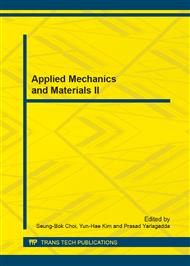[1]
BAKER C.J.; Wind engineering— past, present and future. Journal of Wind Engineering and Industrial Aerodynamics. v. 95, p.843–870, (2007).
DOI: 10.1016/j.jweia.2007.01.011
Google Scholar
[2]
POPE, S. B.; RAE, W. H.; BARLOW, J.B. Low-Speed Wind Tunnel Testing. 3. ed. New York: John Wiley & Sons, 1999. 714p.
Google Scholar
[3]
MERRISON, Jonathan Peter et al. An environmental simulation wind tunnel for studying Aeolian transport on mars. Planetary and Space Science. Maryland Heights. v. 56, n. 3-4. pp.426-437, (2008).
DOI: 10.1016/j.pss.2007.11.007
Google Scholar
[4]
POPE, Stephen B. Turbulent flows. 1. ed. Cambrigde: Cambridge University Press, 2000. 771p.
Google Scholar
[5]
REZENDE, André Luiz Tenório. Análise numérica da bolha de separação do escoamento turbulento sobre uma placa plana fina inclinada. 2009. 263f. Thesis (Doutorado) – Pontifícia Universidade Católica do Rio de Janeiro, Rio de Janeiro.
DOI: 10.17771/pucrio.acad.14607
Google Scholar
[6]
ZHANG, Chunchao. Simulation of a turbulent separation bubble using RANS. 2012. 95f. Dissertation (Master's Degree) – Université du Québec, École de technologie supérieure, Montréal.
Google Scholar
[7]
NA, Y.; MOIN, P. Direct Numerical Simulation of a separated turbulent boundary layer. Journal of Fluid Mechanics. Cambridge University Press. v. 374. pp.379-405, (1998).
DOI: 10.1017/s0022112098009987
Google Scholar
[8]
FERREIRA, V. G. et al. Application of a bounded upwinding scheme to complex fluid dynamics problems. Mathematical and Computer Modelling. v. 57. pp.435-459, (2013).
DOI: 10.1016/j.mcm.2012.06.021
Google Scholar
[9]
BERCOVICI, M. et al. Compact adaptive-grid scheme for high numerical resolution simulations of isotachophoresis. Journal of Chromatography A. v. 1217. pp.588-599, (2010).
DOI: 10.1016/j.chroma.2009.11.072
Google Scholar
[10]
ÇENGEL, Yunus; CIMBALA, John. Mecânica dos Fluidos: Fundamentos e Aplicações. 1. ed. São Paulo: McGraw-Hill, 2007. 819 p.
Google Scholar
[11]
SENGUPTA, Anindya; SARKAR, Partha P. Experimental measurement and numerical simulation of an impinging jet with application to thunderstorm microburst winds. Journal of Wind Engineering and Industrial Aerodynamics. Amsterdam. v. 96, n. 3, pp.345-365, Mar. (2008).
DOI: 10.1016/j.jweia.2007.09.001
Google Scholar
[12]
VERSTEEG, H. K.; MALALASEKERA, W. An Introduction to Computational Fluid Dynamics – The Finite Volume Method. 2. ed. Essex: Pearson Education Limited, 2007. 503p.
Google Scholar
[13]
ANSYS. CFX Solver Theory manual. Version 14. 5. Ansys, (2012).
Google Scholar
[14]
BOURIGA, M.; LEMYRE-BARON, J. -S.; MORENCY, F.; and WEISS, J. Preliminary Experimental and Numerical Investigations of the Flow inside a Boundary Layer Wind Tunnel. Proceedings of the 21st Conference of the CFD Society of Canada, Sherbrooke, QC, Canada, May (2013).
DOI: 10.1139/tcsme-2014-0034
Google Scholar


